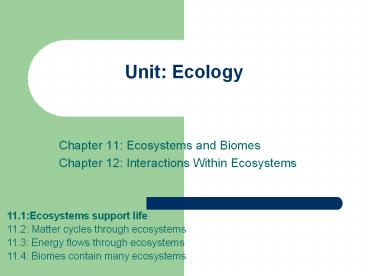Unit: Ecology - PowerPoint PPT Presentation
Title:
Unit: Ecology
Description:
Title: PowerPoint Presentation Last modified by: WESTERLY SCHOOL Created Date: 1/1/1601 12:00:00 AM Document presentation format: On-screen Show (4:3) – PowerPoint PPT presentation
Number of Views:52
Avg rating:3.0/5.0
Title: Unit: Ecology
1
Unit Ecology
- Chapter 11 Ecosystems and Biomes
- Chapter 12 Interactions Within Ecosystems
11.1Ecosystems support life 11.2 Matter cycles
through ecosystems 11.3 Energy flows through
ecosystems 11.4 Biomes contain many ecosystems
2
Concept Overview
- Temperature can vary from place to place
- 1. It surrounds all living things
- 2. All living organisms need it
- 3. It gives Earth most of its energy
- A. organism
- B. energy
- C. the ocean
- D. environment
- E. the sun
- 1. d, 2. b, 3. e
3
Living things depend on the environment
- Ecology the scientific study of how organisms
interact with their environment and all the other
organisms that live in that environment - Ecosystem describes a particular environment and
all the living things that are supported by it - Ex pond, desert
- Important how the living parts of the ecosystem
relate to the nonliving parts
4
Living things depend on the environment
- Pond
- Biotic factors living parts
- water, fish, plants in and around, animals feed
on the plants, fish feed on microorganisms in the
water - Abiotic factors nonliving parts
- Air (carbon dioxide and oxygen), soil
(nutrients), water, sunlight
5
Biotic factors interact with an ecosystem
- Living things depend upon an ecosystem, and also
have an impact on the ecosystem in which they
live - Plants (biotic) affect biotic and abiotic parts
of ecosystems - Biotic
- An important source of food help determine
types of animals that can live there - Abiotic
- affect temperature by blocking sunlight
- Roots hold soil in place
- Photosynthesis - Carbon dioxide and oxygen
- Animals (biotic) affect ecosystems
- Ex beaver builds a dam which changes the flow of
a river and affects the surrounding landscape - Ex herds of cattle can overgraze a grassland
causing soil erosion, and climate impacts - Ex corals form giant reefs that provide food and
shelter for marine organisms - Other examples?
6
Many abiotic factors affect ecosystems
- Physical parts
- You can see or feel temperature, rainfall, water
level, sunlight, etc. - Chemical parts
- Minerals and compounds in the soil and water
- Fresh/salty water
- Abiotic factors determine what organisms the
ecosystem will support
7
(No Transcript)
8
Abiotic Factor Temperature
- Affects types of plants that will do will in an
ecosystem, which determines the types of animals
that can live there - Ex Rainforest temperatures affect the plants
that can grow and support a variety of monkeys,
birds, and others - Ex musk oxen have at hick coat of fur for
survival in very cold environments (-40F), water
buffalo has a light coat better for warmer
temperatures
9
Abiotic Light
- Sunlight and temperature are related
- Sunlight is also used for energy photosynthesis
- The food from plants supports almost all other
living things on Earth - Strength and amount of sunlight are important
- Desert cacti can survive where sunlight is
strong - Forest mosses and ferns do well with less light
- Ocean Ecosystems deeper water, less light
- Photosynthesis only performed to the first
hundred meters below the surface
10
Euphotic (or photic) zone- the depth of the
water in a lake or ocean, that is exposed to
sufficient sunlight for photosynthesis to occur.
11
Abiotic Soil
- Soil mixture of small rock and minerals
- Organisms in the soil can break down the remains
of dead plants and animals - This decay provides important raw materials to
living plants and animals - Soil types vary and affect plant growth
- Lots of decaying, or organic, matter holds water
well and allows air to reach plant roots - Sandy soil holds water poorly
- Clay soil small packed particles, does not
aerate well - Minerals
12
Abiotic Water
- All living things need water to carry out life
processes - Plants need water for photosynthesis
- Animals need water to digest food and release
energy stored in the food - Desert Oasis forms when underground water comes
to the surface - Ecosystesm with lots of water can support a large
number of different types of plants, which in
turn support a variety of types of animals - Rainforest vs desert
- the types and number of living things in a
land ecosystem will always be related to the
amount of fresh water available for its
inhabitants
13
(No Transcript)
14
(No Transcript)
15
- http//www.glencoe.com/sites/common_assets/science
/virtual_labs/CT08/CT08.html































